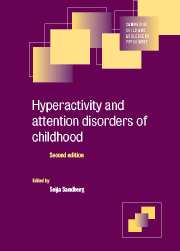Book contents
- Frontmatter
- Contents
- List of contributors
- Preface
- 1 Historical Development
- 2 Epidemiological aspects: what have we learned over the last decade?
- 3 Cross–cultural/ ethnic aspects of childhood hyperactivity
- 4 4 Sex differences and their significance
- 5 Classification issues
- 6 The role of attention
- 7 Cognitive aspects and learning
- 8 Developmental perspectives
- 9 Behavioural and molecular genetic studies
- 10 Biological underpinnings of ADHD
- 11 Psychosocial contributions
- 12 Institutional care as a risk factor for inattention/overactivity
- 13 Treatments: The case of the MTA study
- 14 Attention feficit hyperactivity disorder in adults
- Index
10 - Biological underpinnings of ADHD
Published online by Cambridge University Press: 28 August 2009
- Frontmatter
- Contents
- List of contributors
- Preface
- 1 Historical Development
- 2 Epidemiological aspects: what have we learned over the last decade?
- 3 Cross–cultural/ ethnic aspects of childhood hyperactivity
- 4 4 Sex differences and their significance
- 5 Classification issues
- 6 The role of attention
- 7 Cognitive aspects and learning
- 8 Developmental perspectives
- 9 Behavioural and molecular genetic studies
- 10 Biological underpinnings of ADHD
- 11 Psychosocial contributions
- 12 Institutional care as a risk factor for inattention/overactivity
- 13 Treatments: The case of the MTA study
- 14 Attention feficit hyperactivity disorder in adults
- Index
Summary
The clinical diagnosis of International Classification of Disease (ICD-10) hyperkinetic disorder (HKD: World Health Organization, 1992, 1993) is a restricted subset of Diagnostic and Statistical Manual of Mental Disorders (DSM-IV) attention deficit hyperactivity disorder (ADHD: American Psychiatric Association, 1994), due to more rigorous inclusion and exclusion criteria (Swanson et al., 1998a; Chapter 5). Given the high degree of comorbidity in ADHD (Jensen et al., 1997), it has generally been agreed that neurobiological studies of ADHD should begin by focusing on the ‘refined’ phenotype of combined-type ADHD. For simplicity, we will refer to this refined phenotype as ADHD unless otherwise specified. A fully delineated testable neurobiological formulation of ADHD is not yet at hand. However, advances in neuropsychology (Chapters 6 and 7) and molecular genetics (Chapter 9), along with recent pivotal studies from clinical and basic neurosciences, to be reviewed below, suggest that a reasonable ‘circuit diagram’ can now be delineated. We previously presented preliminary formulations (Castellanos, 1997; Swanson and Castellanos, 1998) that are developed here in greater detail. There is as yet no general agreement on the psychological deficit or deficits that underlie ADHD. Explanatory concepts such as inhibition, impulsivity and attention are generally evoked, although they have not been sufficiently well defined to test their applicability to ADHD definitively. For heuristics reasons, we will take as our starting point Van der Meere's proposal (Chapter 6) that ADHD represents primarily a disorder of state regulation and will grapple with one basic question.
- Type
- Chapter
- Information
- Hyperactivity and Attention Disorders of Childhood , pp. 336 - 366Publisher: Cambridge University PressPrint publication year: 2002



